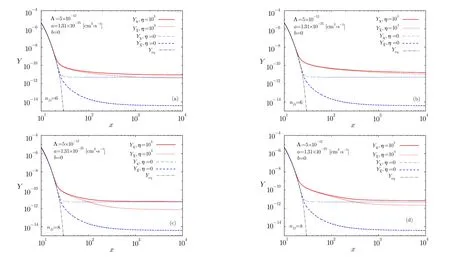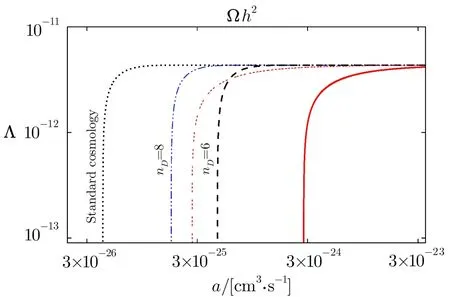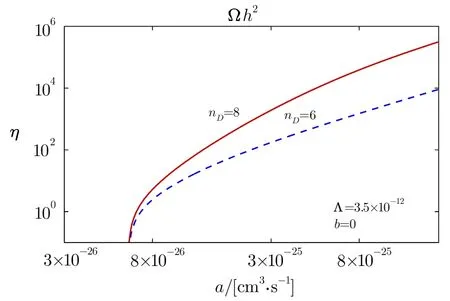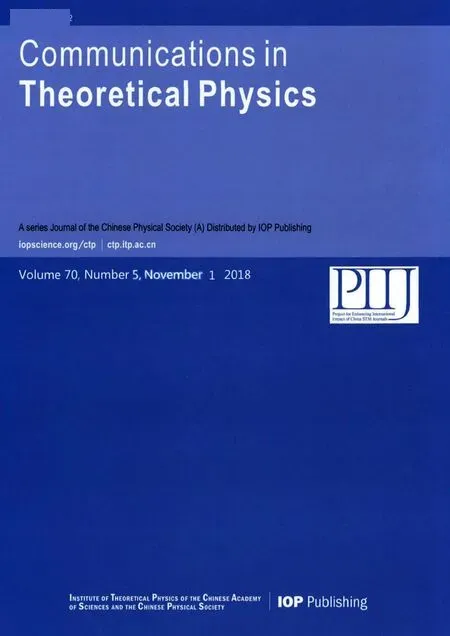Relic Density of Asymmetric Dark Matter in Modified Cosmological Scenarios?
Hoernisa Iminniyaz(吾爾尼沙·依明尼亞孜),Burhan Salai(博爾汗·沙來),and Guo-Liang Lv(呂國梁)
School of Physics Science and Technology,Xinjiang University,Urumqi 830046,China
AbstractWe discuss the relic abundance of asymmetric Dark Matter particles in modified cosmological scenarios where the Hubble rate is changed with respect to the standard cosmological scenario.The modified Hubble rate leaves its imprint on the relic abundance of asymmetric Dark Matter particles if the asymmetric Dark Matter particles freeze–out in this era.For generality we parameterize the modification of the Hubble rate and then calculate the relic abundance of asymmetric Dark Matter particles and anti–particles.We find the abundances for the Dark Matter particles and anti–particles are enhanced in the modified cosmological models.The indirect detection signal is possible for the asymmetric Dark Matter particles due to the increased annihilation rate in the modified cosmological models.Applying Planck data,we find the constraints on the parameters of the modified cosmological models.
Key words:asymmetric dark matter,modified cosmological scenarios,relic density
1 Introduction
Recent Planck team’s full sky measurements of Cosmic Microwave Background(CMB)temperature anisotropies provide the precise values for the cosmological parameters,the amount of cold Dark Matter(DM)relic density is given as

where h=0.673±0.098 is the present Hubble expansion rate in units of 100 km ·s?1·Mpc?1.[1]
Although the precise value of the Dark Matter relic density is given by the observations,the nature of Dark Matter is still a mysterious question for scientists.Experimental searches are ongoing to find the Dark Matter using direct detection or indirect detection.Parallel to the experiments,there are also many theoretical works which attempts to disclose the character of Dark Matter.One of the general belief is that the Weakly Interacting Massive Particles(WIMPs)are the good candidates for Dark Matter.Majorana particle neutralino is one of the favorite WIMP which is appeared in supersymmetry and its particle and anti-particle are the same.Because we have no evidence that shows that the Dark Matter should be Majorana particle,we still have other possibilities that the Dark Matter can be Dirac particles for which its particle and anti-particle are different.[2?3]The relic density of asymmetric Dark Matter is calculated in the standard cosmological scenario.[4?5]In the standard model of cosmology,it is assumed that Dark Matter particles were in thermal and chemical equilibirum in the radiation-dominated epoch after the period of last entropy production.Dark Matter particles decouple when they become nonrelativistic while the universe cools down.For asymmetric Dark Matter,the asymmetry is created well before the decoupling of the asymmetric Dark Matter particles according to the assumption,therefore there are more particles than the anti-particles in the beginning.Dark Matter antiparticles are annihilated away with the particles and the rest are the Dark Matter particles in the present universe.The direct ditection can be used to find the asymmetric Dark Matter particles in principle.
On the other hand,there is no observational evidence before Big Bang Nucleosynthesis(BBN).The alternative cosmological models like scalar-tensor gravity,[6]quintessence models with a kination phase,[7?10]brane world cosmology[11?14]or the late decaying of inflaton model[15?17]and anistropic expansion[18?19]predict that the expansion rate may have been different from the one expected by the standard Friedmann-Robertson-Walker model before BBN.If this occurs around the time when the asymmetric Dark Matter particles decouple from the thermal equilibrium,the relic abundance of asymmetric Dark Matter particles are affected by the modified expansion rate of the universe.The papers[20?25]already discussed the effects of the modified expansion rate on the relic density of asymmetric Dark Matter particles.In those papers,the authors concluded that the enhanced expansion rate leads to the earlier asymmetric Dark Matter particles freeze-out and enhanced relic density. In the modified cosmological models,the difference of the abundance between the particle and anti-particle is not large for reasonable annihilation cross sections.In order to match with the observed range of the Dark Matter relic density,the annihilation cross section should be large.Then the annihilation rate is increased and it leads to the possible indirect detection signal for asymmetric Dark Matter as well.[21,23,25]In this work,we present the generalized parametrization of the modification of the expansion rate of the early universe and derive the general equation to compute the relic density of asymmetric Dark Matter particles.Then we use the Planck data to find the constraints on the parameter space of the modified cosmological models.
The next section is devoted to the analysis of the relic density of asymmetric Dark Matter particles in modified cosmological scenarios both in numerical and analytical ways.In Sec.3,using the Planck data,we find the constraints on the parameter space for the modified cosmological models.There is conclusion and summary in the final section.
2 Relic Density of Asymmetric Dark Matter in Modified Cosmological Scenarios
In this section,we introduce the parameterization of modification of the expansion rate of the universe and then derive the generalized equation to calculate the relic density for asymmetric Dark Matter.To describe the effects of the revised Hubble expansion rate in the early universe,we add the new dark density to the Friedmann equation as


is the radiation energy density with g?being the effective number of relativistic degrees of freedom and

where
here ρDparameterizes the modification of the expansion rate.nDis the constant which parametrizes the behavior of the energy density.We introduce

where T0is the reference temperature,which approaches to the freeze-out temperature,then

The approximation holds in a range of temperatures where g?does not change sizably with respect to its value at T0.At BBN time,the radiation energy density remains dominant,and the new term in the Hubble rate should vanish in order not to conflict with the BBN prediction.When nD=6,the new dark density corresponds to the quintessence model with kination phase;and nD=8 refers to the brane world cosmology or the late decaying of inflaton field.
The number densities of the asymmetric Dark Matter particles are resolved by the following Boltzmann equations,

Here only χˉχ pairs can annihilate into Standard Model(SM)particles according to the assumption.nχ,nˉχare the number densities of particle and anti-particle. ?σv?represents the product of thermal average of the annihilation cross section and the relative velocity of the Dark Matter particle and anti-particle.The equilibrium number densities of χ andare(in equilibrium,the chemical potential of the particlesμˉχ=?μχ)

where gχis the number of intrinsic degrees of freedom of the particles.

is the entropy density with the effective number of entropic degrees of freedom g?s.Assuming that the universe expands adiabatically and using the entropy conservation sR3where R is the scale factor of the universe,we obtain

Inserting Eq.(9)into Eq.(10)and using x=m/T,we have


Then using Eq.(12),with the modified expansion rate,the Boltzmann equations(7)are rewritten as

From Eqs.(13),(14),we obtain

This hints that the difference of the abundance of the particles and anti–particles are conserved,

where Λ is constant.Then Eqs.(13),(14)become


where a,b represent the s-wave contribution for the limit v→0 and the p-wave contribution for the suppressed s-wave annihilation.
2.1 Numerical Solutions
In the standard frame of the Dark Matter particle evolution,it is assumed the particles χ andˉχ were in thermal equilibrium at high temperature,when the temperature drops below the mass(T

Fig.1(Color online)Evolution of Yχand Yˉχas a function of the inverse-scaled temperature x for nD=6 and nD=8.η =103for panels(a),(c)and η =104for panels(b),(d).Here Λ =5 × 10?12,m=100 GeV,gχ =2,g? =90,a=1.31×10?25cm3·s?1,b=0,x0=25.
Figure 1 demonstrates the evolution of the abundances for particle and anti–particle for different nDand η.These plots are based on the numerical solutions of Eqs.(17),(18).As we mentioned earlier nD=6 corresponds to the quintessence scenario with kination phase while nD=8 is for the brane world cosmology or the late inflaton decay model.We find the abundances for particle and antiparticle are increased in those models.The increase depends on the enhancement factor η,when nD=6,we see that the increase is larger for η=104in Fig.1(b)compared to η=103in Fig.1(a).The situation is the same for nD=8 in Figs.1(c)and 1(d).On the other hand,it is shown the increase of the relic abundance is larger for smaller nDwhen η takes the same value.The reason for the increases of the relic abundances for particle and anti–particle are the enhanced Hubble expansion rate in those modified cosmological models.The enhanced Hubble expansion rate of the universe leads to the early decay of the asymmetric Dark Matter particles from the equilibrium state.Therefore,there are more particles and anti-particles in the modified scenarios with respect to the standard cosmological scenario.
2.2 Analytical Solutions
First,we find the analytic solution for Eq.(18),and then obtain the solution for Eq.(17)using the relation.In terms ofEq.(18)is written as

Repeating the same method which is mentioned in Ref.[5],we obtain

for high temperature.The inverse-scaled freeze-out temperatures xFandare determined by this solution.[5]For sufficiently low temperature,we obtain

where

The relic abundance for χ particle is


where

The predicted present total Dark Matter relic density is then

According to the assumption that the deviationis of the same order of the equilibrium value ofthe freeze-out temperature foris fixed using the equalitywhere ξ being a constant,usually[26]
3 Constraints
The Dark Matter relic density is given by Planck date as in Eq.(1).The contour plot of the s-wave annihilation cross section a and asymmetry factor Λ is displayed in Fig.2 when the Dark Matter relic density is?DMh2=0.1199.Here the dashed(black)line is for nD=6,the double dot–dashed(blue)line is for nD=8 and the dotted(black)line is for the standard cosmology.We find the cross sections are larger for the modified cosmological models with respect to the standard cosmology.The relic density is larger in modified cosmology due to the enhanced Hubble rate,therefore the cross section should be increased in order to satisfy the observed range of the Dark Matter relic density.Of course the increased value of the cross section depends on the parameter nD.For smaller nD(dashed line),the larger cross section is needed to satisfy the observed range of Dark Matter relic density,for example,the cross section changes from 4.6×10?25cm3·s?1to 3.5×10?23cm3·s?1for nD=6 and 1.8× 10?25cm3·s?1to 3.5× 10?23cm3·s?1for nD=8.Here Λ takes the value from Λ =9.0 × 10?14to Λ =4.4 × 10?12.We can analyze this from panels(a)and(c)in Fig.1.For the same η,the increase of relic abundance is larger for nD=6 with respect to the case nD=8,therefore the annihilation cross section should be large to satisfy the observed range of the Dark Matter abundance for smaller nD.
Since the annihilation cross sections of the asymmetric Dark Matter particles in the modified cosmological scenarios are increased,then the annihilation rate is enhanced and the indirect detection is possible for the asymmetric Dark Matter particles,which is originally assumed to be detected only through the direct detection due to the suppressed abundance of the anti-particles.Therefore we can use the Fermi Large Area Telescope(Fermi-LAT)[27]data to find the limiting cross sections for the asymmetric Dark Matter in nonstandard cosmological scenarios.In the case of the symmetric Dark Matter,the annihilation rate is[21]

where ρDM= ρcrit?DMandis the thermal average of the self annihilation cross section.For asymmetric Dark Matter,the annihilation rate is


According to the analysis of Ref.[21],the ratio of Γasymand ΓFermimust be less than one,


Fermi-LAT provides the following uppor bounds on the annihilation cross section a=1.34× 10?25cm3·s?1forchannel and a=1.38×10?24cm3·s?1forchannel while m=100 GeV.[27]Applying Planck data Eq.(1)and Fermi-LAT data to Eq.(32)together,we obtain the limiting bound for the annihilation cross sections in the modified cosmological scenarios.We find when Λ=9×10?14,forchannel,the corresponding constrained cross sections are?σv?≤ 2.7 × 10?25cm3·s?1(three dot–dashed line in Fig.2);forchannel,it iscm3·s?1(thick red line in Fig.2).

Fig.2 (Color online)The allowed region in the(a,Λ)plane for different nDand standard cosmology when the Dark Matter relic density ?h2=0.1199.Here m=100 GeV,gχ =2 and g?=90,x0=25,η =103.The three dot-dashed(red)line is the limiting cross section,which corresponds to the Fermi-LAT bounds for channel and the thick(red)line is forchannel.[27]

Fig.3 (Color online)The allowed region in the(a,η)plane for b=0 when the Dark Matter relic density ?h2=0.1199.Here we take m=100 GeV,Λ =3.5× 10?12,gχ =2 and g?=90,x0=25.The dashed(blue)line is for nD=6 and the thick(red)line is for nD=8.
Figure 3 demonstrates the relation between the s–wave annihilation cross section a and the enhancement factor η when ?h2=0.1199.In this plot,we take the value for asymmetry factor as Λ =3.5 × 10?12which is in the range of the values to obtain the observed Dark Matter abundance.It is indeed shown in Fig.2.Here the thick(red)line is for nD=8 and the dashed(blue)line is for nD=6.While nD=8,for the cross sections from 6.2×10?26cm3·s?1to 1.9× 10?24cm3·s?1,η changes from 0.1 to 3.1×105and to 9.0×103when nD=6.For the same cross section,the enhancement factor η is increased for larger nD.We can understand the reason from Fig.1.In the frame(b)and(c)of Fig.1,the cross section is same for nD=6 and nD=8.We find for smaller nD,there are more increase of asymmetric Dark Matter relic density for η =104in Fig.1(b)than the case for η =103in Fig.1(c).In order to fall the observed range of Dark Matter relic density,η should be decreased(increased)for small(large)value of nD.
In this work,we use the observed Dark Matter abundance to derive the constraints on the enhancement factor for the fixed asymmetry factor Λ.In the quintessence model(nD=6),the constraint on the enhancement factor from BBN is η<30,[29]which matches partly with the limit η <9.1×103that we obtained.In paper,[29]the bound on η was obtained at the temperature T=10 MeV,here we take this bound as an example of a reference.As we mentioned earlier nD=8 corresponds to the brane Randall-Sundrum II model,[11]which in our notations representswith λ being the tension of the brane which is related to the 5-dimensional Planck mass M5by,here MPis the 4-dimensional Planck mass.[23]From Fig.3,we see that η <3.1×105,this implies λ>1.9 GeV4and it leads M5>103TeV.The BBN bound is λ>1 MeV4and so M5>30 TeV.[30]
4 Summary and Conclusions
We have studied the relic density of asymmetric Dark Matter particles in the modified cosmological scenarios.We have no observational evidence for the early pre-BBN universe.There are different cosmological models,which predicted the Hubble expansion rate before BBN may be faster or slower than the standard expansion law.If the Hubble expansion rate is changed in the modified cosmological scenarios,it affects the relic density of asymmetric Dark Matter particles.We have discussed in which extent the modification of the Hubble expansion rate affects the relic density of asymmetric Dark Matter in the modified cosmological models.
The Hubble expansion rate of the universe is increased in the modified cosmological scenarios like quintessence with kination phase,brane world cosmology or the late inflaton decay model and etc.For generality we found the parameterization of the enhancement of the Hubble expansion rate.Then we calculated the relic density of asymmetric Dark Matter particles in the modified cosmological scenarios where the expansion rate is faster than the standard cosmological scenarios.We found the resulting relic abundances are increased.Since the expansion rate of the universe is enhanced during the era of asymmetric Dark Matter decoupling,the asymmetric Dark Matter particles decouple from the thermal equilibrium earlier than the standard cosmological scenario and there are increased relic densities for particles and anti-particles.The increases depend on the enhancement factor η as well as the cross section and the factor nD.While using Planck date for the relic density of asymmetric Dark Matter,we found the cross sections are boosted for the modified cosmological models in order to satisfy the observed Dark Matter relic density.From the contour plot of(a,η),we found η is decreased(increased)for small(large)value of nDwhen the cross section is same for different nD.
The generalised formula obtained provides the relic density calculation of the asymmetric Dark Matter particles for the different modified cosmological scenarios where the expansion rate is enhanced.In the standard cosmological model,the abundance of minority component of asymmetric Dark Matter is suppressed.For the modified cosmological models,we obtained the enhanced relic densities both for particles and anti-particles,of course the increased amount of the relic abundance depends on the size of the annihilation cross section.The annihilation cross section should be boosted in order to provide the observed range of Dark Matter relic density(1).The corresponding annihilation rate is increased too.This effect is contrary to the general belief that the asymmetric Dark Matter is only detected by direct detection.In modified cosmological scenarios,we have the possibility to detect the asymmetric Dark Matter particle in indirect way.The asymmetric Dark Matter particle properties may be constrained by the indirect detection signals.[27]In addition to the observational Dark Matter relic density,[1]there are collider,direct and indirect detection signals,using those data the parameter space is examined before BBN.
 Communications in Theoretical Physics2018年11期
Communications in Theoretical Physics2018年11期
- Communications in Theoretical Physics的其它文章
- Numerical Study of Unsteady MHD Flow and Entropy Generation in a Rotating Permeable Channel with Slip and Hall Effects?
- Hierarchical Human Action Recognition with Self-Selection Classifiers via Skeleton Data?
- Spin Thermoelectric Effects in a Three-Terminal Double-Dot Interferometer?
- Third-Order Magnetic Susceptibility of an Ideal Fermi Gas?
- Coherent Control of the Hartman Effect through a Photonic Crystal with Four-Level Defect Layer?
- Linear Analyses of Langmuir and EM Waves in Relativistic Hot Plasmas?
